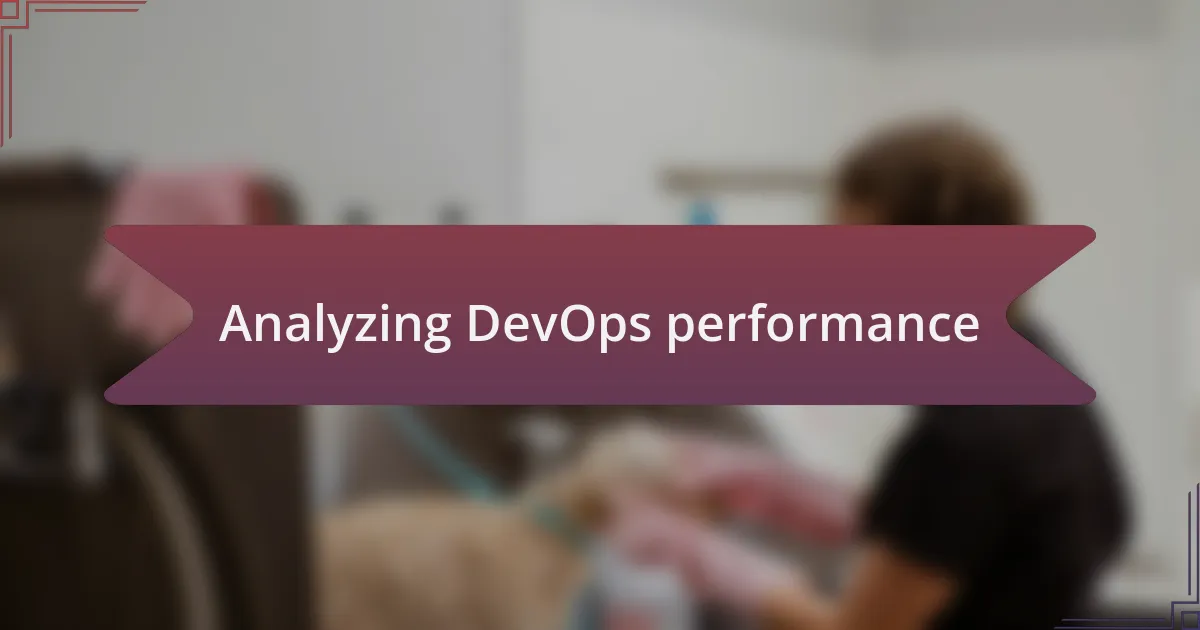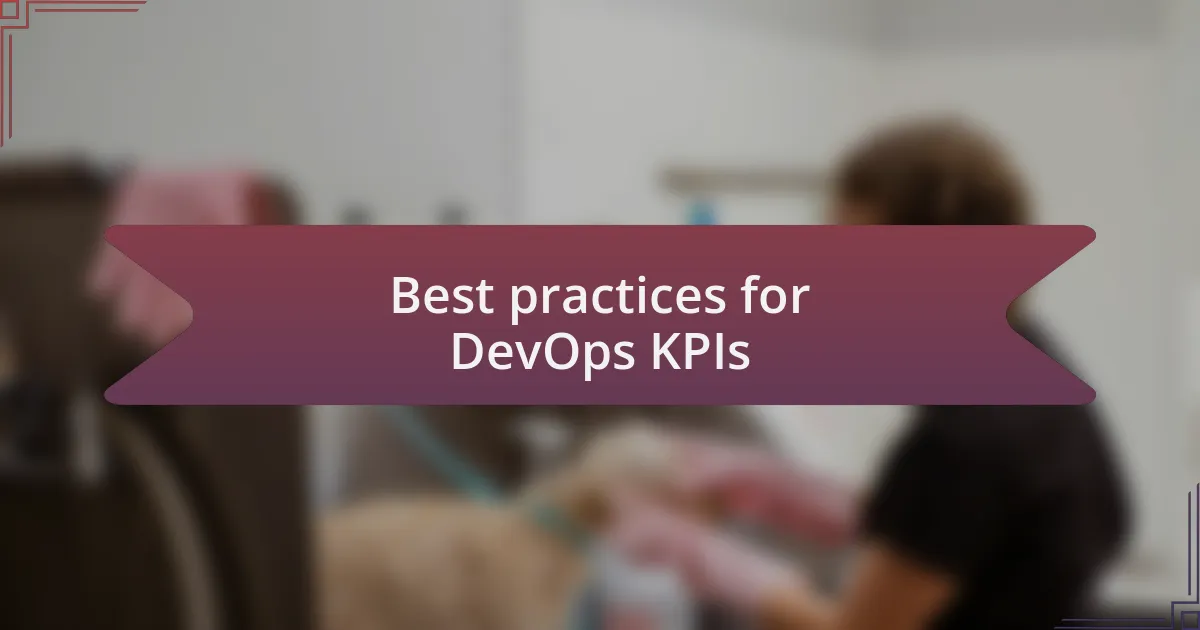Key takeaways:
- DevOps metrics, such as Lead Time and Change Failure Rate, provide actionable insights that help teams improve their processes and enhance deployment stability.
- Clear and meaningful KPIs align team objectives with business goals, fostering a sense of direction and motivation among team members.
- Successful measurement of DevOps relies on combining quantitative metrics with qualitative feedback to ensure comprehensive understanding and team cohesion.
- Best practices for DevOps KPIs include simplicity, actionability, and fostering a culture of continuous feedback for more effective performance management.

Understanding DevOps metrics
DevOps metrics provide a vital lens into the health of our development processes. I remember my early days working in a team where we relied heavily on gut feelings rather than data. It was frustrating—how could we truly know if our deployments were successful or if we were just lucky? That’s where metrics come into play, giving us concrete evidence of what’s working and what isn’t.
When I first encountered the concept of Lead Time for Changes—a key metric in DevOps—I realized how impactful it could be. It measures the time it takes for a code change to go from commit to production. This helped my team understand delays better. Have you ever been stuck on a project, wondering why it’s taking so long? Tracking this metric can unveil bottlenecks, making it easier to target specific areas for improvement.
Another critical metric is the Change Failure Rate, which helps assess the stability of our deployments. I once worked on a project where we noticed a steady increase in this rate. It was concerning and made me question our deployment practices. Were we rushing? Were our tests inadequate? This metric isn’t just numbers; it’s reflective of our team’s quality of work and fosters a culture of accountability and continuous learning. So, how do you currently measure your success?

Importance of KPIs in DevOps
KPIs in DevOps are crucial because they provide measurable goals that align with business objectives. Reflecting on my experience, having clear KPIs fostered a sense of direction within my team. I often found myself asking, “Are we hitting the targets that matter?” When we tracked our deployments against specific KPIs, it galvanized our efforts and connected our daily activities to broader company goals.
Designating meaningful KPIs allows teams to celebrate successes and identify areas for growth. I remember a project where we focused on Deployment Frequency—a metric that quickly revealed how often we delivered updates. Initially, it felt daunting, but as we improved our processes, each deployment felt like a victory. Isn’t it satisfying to see your hard work reflected in tangible results? Tracking such metrics not only motivates us but also unites the team under common goals.
What really struck me was how KPIs serve as a feedback loop. In one instance, our team adjusted our approach after analyzing our mean time to recovery. Rather than relying on assumptions, we made data-driven decisions. Isn’t it empowering to know that we can use metrics to clarify our workflow and improve our outcomes? By focusing on KPIs, we ultimately create a culture of transparency and learning, fostering innovation in our processes.

Key DevOps metrics to track
When it comes to key DevOps metrics, one that I find invaluable is Lead Time. This metric measures the time it takes for a code commit to reach production. Reflecting on past projects, I often marveled at how improving this time could lead to faster feedback from users. Isn’t it thrilling to think that just a few optimizations can amplify our impact?
Another vital metric is Change Failure Rate, which tracks the percentage of changes that lead to failures in production. In my experience, when we focused on minimizing this rate, it prompted deeper conversations around quality and testing within our team. I remember a specific instance where a high failure rate pushed us to revamp our testing procedures, leading to more reliable software. What can be more rewarding than seeing a drop in that failure rate alongside user satisfaction?
Don’t overlook the importance of Monitoring and Observability metrics, such as system uptime and performance. Early in my career, I neglected these metrics, only to realize later how they can reveal underlying issues before they escalate. It’s fascinating how a simple dashboard displaying uptime can trigger proactive measures, ultimately creating a smoother experience for users. How can we expect to maintain trust with our users if we aren’t keeping tabs on the health of our systems?

How to measure DevOps success
Measuring DevOps success goes beyond just tracking metrics; it involves understanding their impact on the team and the organization. From my own experience, I’ve found that team morale often improves significantly when we set clear, achievable goals based on performance metrics. Have you ever noticed how a well-defined objective can energize a team, creating a shared sense of purpose that drives collaboration?
One metric I particularly value is Deployment Frequency. It’s not just about how often we deploy code, but the rhythm it creates within the team. I remember a project where we aimed to deploy daily releases, and it transformed our development cycle. The excitement in our stands was palpable, and it fostered a culture of experimentation and rapid feedback. How exhilarating is it to see our efforts manifest in real-time improvements and innovations?
Lastly, I can’t stress enough the importance of User Satisfaction Surveys. While metrics like Lead Time and Change Failure Rate provide quantitative data, understanding our users’ sentiments gives a richer narrative to our success story. When we implemented regular feedback sessions, I was surprised to see how much the user’s insights could influence our direction. Isn’t it incredible how the voice of our users can subtly steer our metrics toward success?

Analyzing DevOps performance
Analyzing DevOps performance requires a clear understanding of the relationship between metrics and outcomes. I’ve often found that focusing solely on numbers can lead to a disconnect. For instance, during a retrospective meeting, we discussed why our lead time data didn’t align with team sentiments. It turned out that despite our impressive metrics, team members felt overwhelmed by the expectation to maintain those numbers.
Performance indicators can reveal a lot, but they shouldn’t be the only lens through which we assess effectiveness. While tracking metrics like Change Failure Rate provides valuable insights into deployment reliability, I believe real understanding comes from diving deeper. I recall an instance when we faced a spike in failures; instead of simply addressing the numbers, we held open forums for team members to express their challenges. The dialogue not only helped us understand the data better but also created a more cohesive team environment.
Delving into the qualitative aspects of our performance is equally important. After analyzing our metrics, I noticed a recurring theme: the lack of cross-team communication. A simple insight from one team member sparked a series of changes that ultimately enhanced collaboration. It made me wonder—how often do we overlook the human element buried beneath layers of data? If we can balance quantitative metrics with qualitative feedback, I believe we can create a more comprehensive view of DevOps performance.

Personal insights on DevOps metrics
When it comes to DevOps metrics, I’ve learned that context is everything. One time, our team was thrilled to see a decrease in lead time, but upon reflecting, I noticed that it stemmed from cutting corners rather than genuine process improvement. This made me question: are we really progressing, or are we just disguising issues with favorable metrics?
Another aspect that has shaped my perspective is the importance of aligning metrics with team goals. During one project, I pushed for tracking deployment frequency, thinking it would motivate the team. However, my enthusiasm was met with eye rolls; they felt it prioritized speed over quality. This experience highlighted for me the need to ensure that metrics resonate with everyone involved. It reminds me, how often do we impose targets without considering their impact on team morale?
Finally, I’ve come to appreciate the power of storytelling in metrics. I recall presenting data during a meeting, and rather than diving into spreadsheets, I shared narratives behind the numbers. By illustrating how a particular performance dip affected one developer personally, I noticed the room’s atmosphere shift—people connected with the data on an emotional level. It’s moments like these that reinforce my belief: metrics should never just be about numbers; they should capture the human experiences driving those figures.

Best practices for DevOps KPIs
Best practices for DevOps KPIs should start with a focus on clarity and simplicity. I remember when I first implemented KPIs in my team; we attempted to track so many metrics that it became overwhelming. We struggled to see the bigger picture until we simplified our focus to just a few key indicators. It was a game changer. How often do we complicate our own processes by overloading ourselves with data instead of honing in on what truly matters?
Another critical practice is ensuring that KPIs are actionable. Early on in my career, I tracked incident resolution time, which sounded valuable on paper. However, it was only when I started pairing that metric with team feedback that I recognized which processes were falling short. This revealed the need to ask: are your KPIs driving real improvements, or are they merely numbers ticking away on a screen?
Lastly, fostering a culture of continuous feedback significantly enhances the effectiveness of KPIs. During a retrospective meeting, I included time for discussing metrics openly. The candid conversations that followed helped us understand how our KPIs affected individual workloads and stress levels. This led me to wonder, how often do we create spaces for our teams to voice their thoughts on metrics? Cultivating that openness not only led to more relevant KPIs but also strengthened our team dynamics.